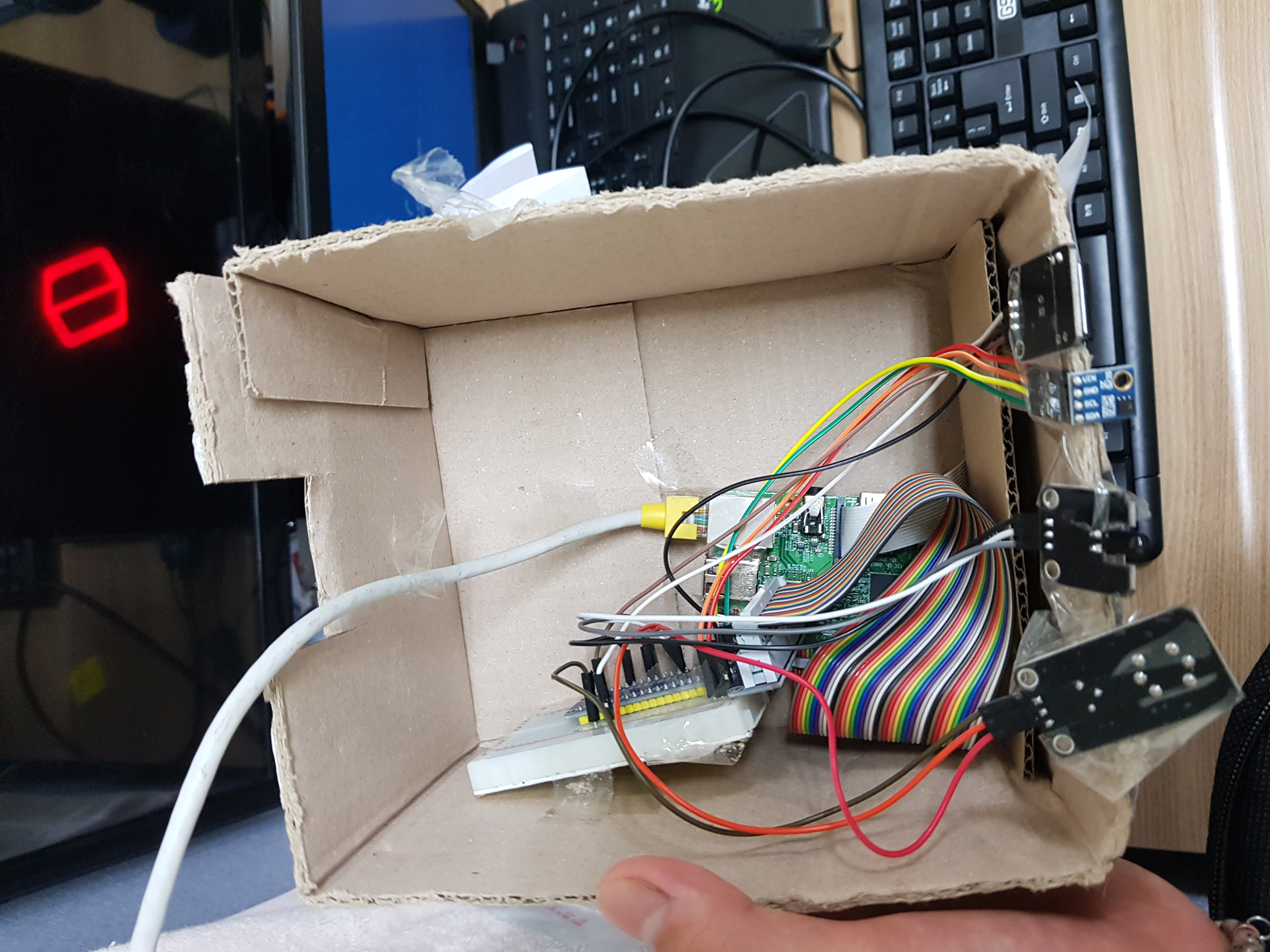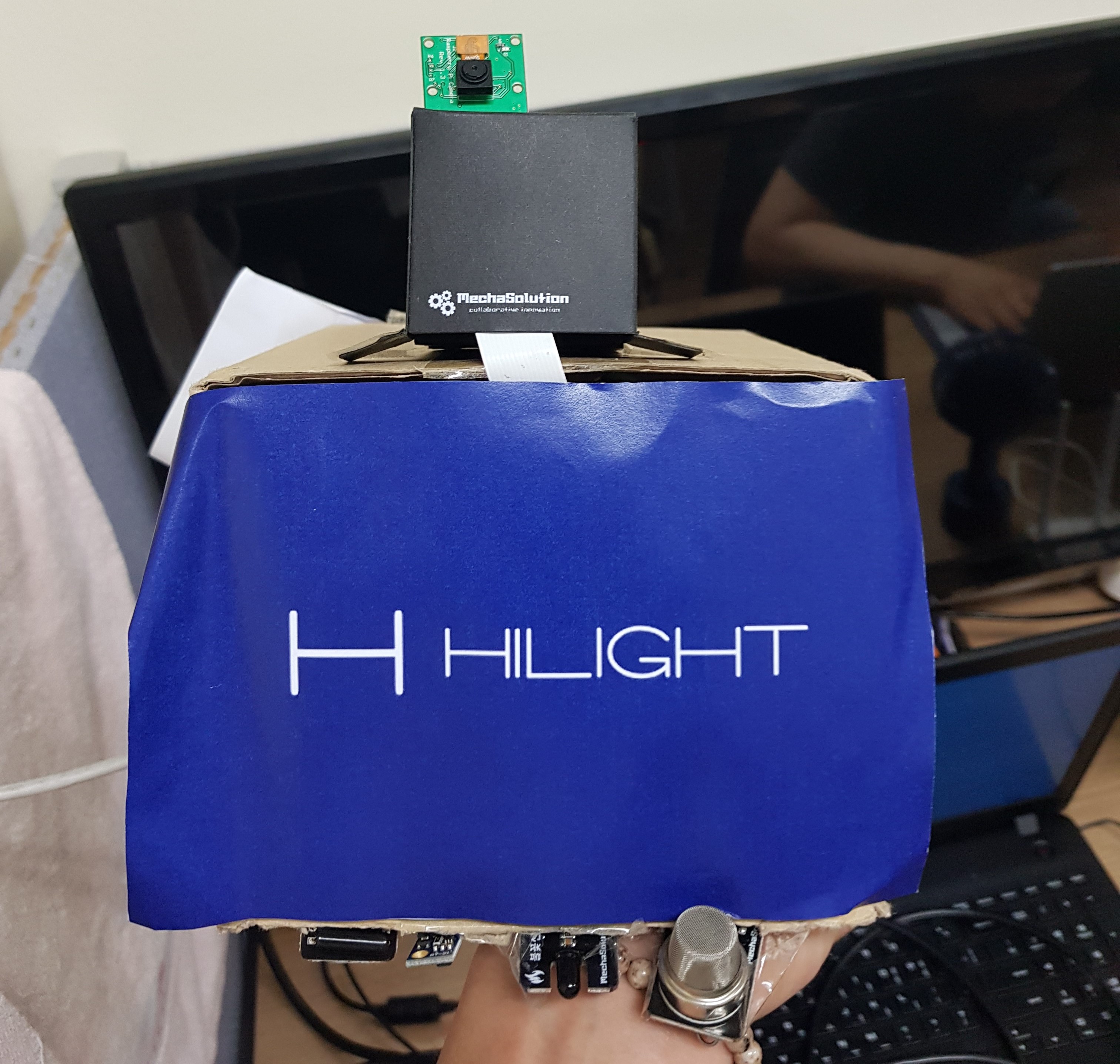라즈베리파이 카메라를 이용한 MJPG 실시간 스트리밍
목차
만약 아직 FFserver와 FFmpeg를 설치하지 않았다면 ubuntu에서 FFmpeg, FFserver 설치하기를 참고하시기 바랍니다.
FFmpeg 사용 법
실행
- bin Directory에 있는 ffmpeg 파일을 실행합니다.
- 꼭 root 권한으로 실행해야 합니다.
# cd ~/bin
# ffmpeg -i 원하는_설정_명령어주의
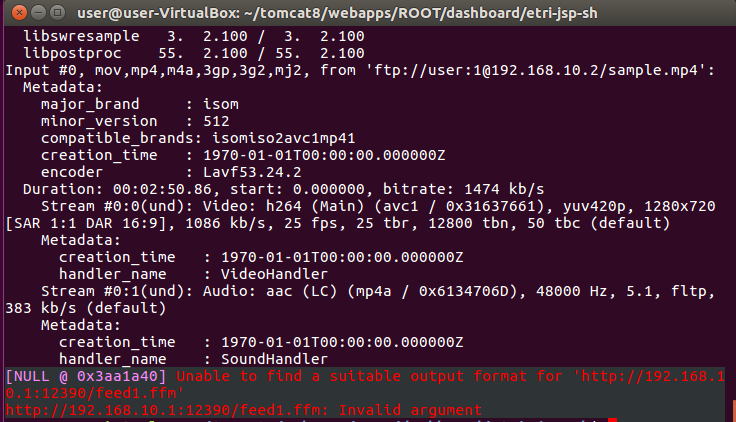
- root 권한으로 실행하지 않을 경우 다음과 같은 오류가 날 수 있습니다.
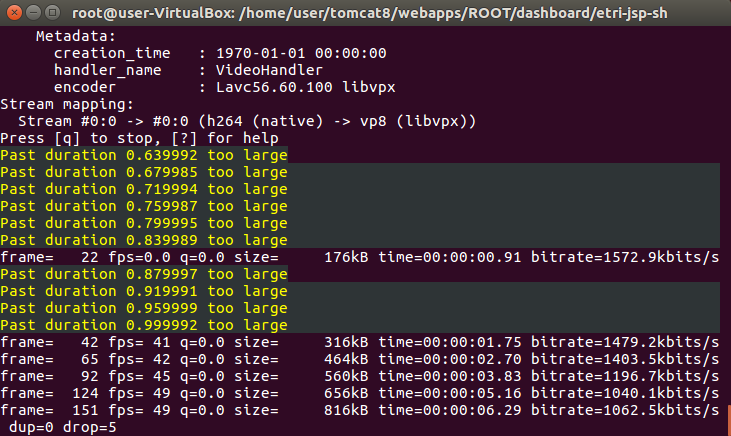
- root 권한으로 실행했을 때는 정상적으로 실행되는 모습을 확인 할 수 있습니다.
FFserver 사용 법
- -f 옵션을 이용하여 .conf 파일에 맞게 ffserver를 동작합니다.
$ ffserver -f config_file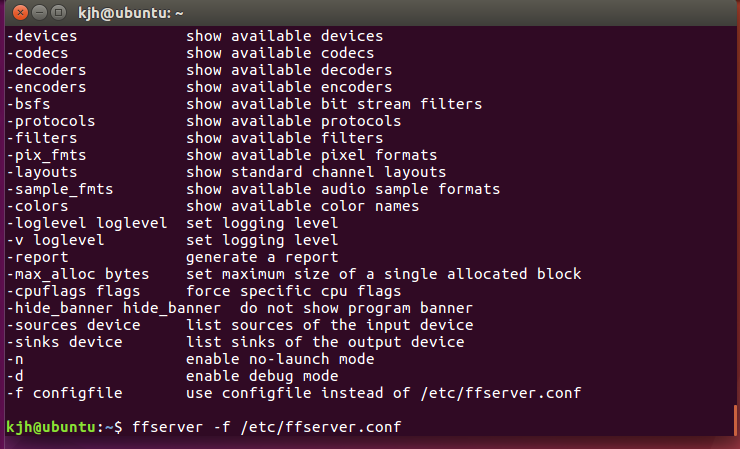
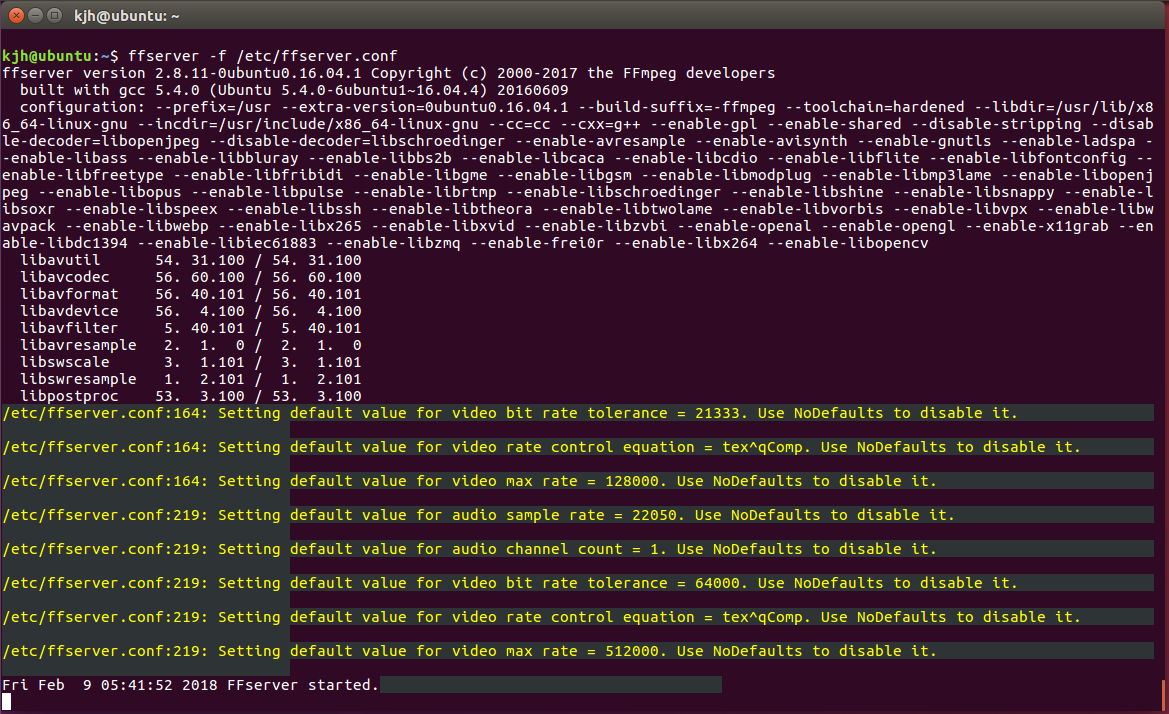
라즈베리파이 카메라를 이용한 MJPG 실시간 스트리밍
라즈베리 파이 환경 설정
-
라즈베리 파이 쉘에서
rpi-update명령어를 통해 필요한 모듈을 다운 받습니다. 처음 한 번만 다운 받습니다. -
라즈베리 파이 쉘에서
modprobe bcm2835-v4l2명령어를 통해 필요한 모듈을 다운 받습니다. 라즈베리 파이를 킬 때마다 명령어를 쳐줘야 합니다.
사용된 ffserver.conf
Port 8090
BindAddress 0.0.0.0
MaxHTTPConnections 2000
MaxClients 1000
MaxBandwidth 10000
CustomLog -
NoDaemon
<Feed feed.ffm>
File /tmp/feed.ffm
FileMaxSize 10M
</Feed>
<Stream TruthCenter/101/fire.mjpg>
Feed feed.ffm
Format mpjpeg
VideoFrameRate 4
VideoSize 600x480
VideoBitRate 80
# VideoQMin 1
# VideoQMax 100
VideoIntraOnly
NoAudio
Strict -1
</Stream>
<Feed feed2.ffm>
File /tmp/feed2.ffm
FileMaxSize 10M
</Feed>
<Stream TruthCenter/102/fire.mjpg>
Feed feed2.ffm
Format mpjpeg
VideoFrameRate 4
VideoSize 600x480
VideoBitRate 80
# VideoQMin 1
# VideoQMax 100
VideoIntraOnly
NoAudio
Strict -1
</Stream>
<Feed feed3.ffm>
File /tmp/feed3.ffm
FileMaxSize 10M
</Feed>
<Stream EngineeringCenter/101/fire.mjpg>
Feed feed3.ffm
Format mpjpeg
VideoFrameRate 4
VideoSize 600x480
VideoBitRate 80
# VideoQMin 1
# VideoQMax 100
VideoIntraOnly
NoAudio
Strict -1
</Stream>
# Server status URL
<Stream status.html>
Format status
# Only allow local people to get the status
</Stream>
# Just an URL redirect for index
<Redirect index.html>
# Redirect index.html to the appropriate site
URL http://www.ffmpeg.org/
</Redirect>사용 된 라즈베리 파이 전체 코드 (파이선으로 구현)
import fcntl
import time
import unittest
import os
import paho.mqtt.client as mqtt
import RPi.GPIO as GPIO
import threading
class SHT21:
"""Class to read temperature and humidity from SHT21, much of class was
derived from:
http://www.sensirion.com/fileadmin/user_upload/customers/sensirion/Dokumente/Humidity/Sensirion_Humidity_SHT21_Datasheet_V3.pdf
and Martin Steppuhn's code from http://www.emsystech.de/raspi-sht21"""
# control constants
_SOFTRESET = 0xFE
_I2C_ADDRESS = 0x40
_TRIGGER_TEMPERATURE_NO_HOLD = 0xF3
_TRIGGER_HUMIDITY_NO_HOLD = 0xF5
_STATUS_BITS_MASK = 0xFFFC
# From: /linux/i2c-dev.h
I2C_SLAVE = 0x0703
I2C_SLAVE_FORCE = 0x0706
# datasheet (v4), page 9, table 7, thanks to Martin Milata
# for suggesting the use of these better values
# code copied from https://github.com/mmilata/growd
_TEMPERATURE_WAIT_TIME = 0.086 # (datasheet: typ=66, max=85)
_HUMIDITY_WAIT_TIME = 0.030 # (datasheet: typ=22, max=29)
def __init__(self, device_number=0):
"""Opens the i2c device (assuming that the kernel modules have been
loaded). Note that this has only been tested on first revision
raspberry pi where the device_number = 0, but it should work
where device_number=1"""
self.i2c = open('/dev/i2c-%s' % device_number, 'r+', 0)
fcntl.ioctl(self.i2c, self.I2C_SLAVE, 0x40)
self.i2c.write(chr(self._SOFTRESET))
time.sleep(0.050)
def read_temperature(self):
"""Reads the temperature from the sensor. Not that this call blocks
for ~86ms to allow the sensor to return the data"""
self.i2c.write(chr(self._TRIGGER_TEMPERATURE_NO_HOLD))
time.sleep(self._TEMPERATURE_WAIT_TIME)
data = self.i2c.read(3)
if self._calculate_checksum(data, 2) == ord(data[2]):
return self._get_temperature_from_buffer(data)
def read_humidity(self):
"""Reads the humidity from the sensor. Not that this call blocks
for ~30ms to allow the sensor to return the data"""
self.i2c.write(chr(self._TRIGGER_HUMIDITY_NO_HOLD))
time.sleep(self._HUMIDITY_WAIT_TIME)
data = self.i2c.read(3)
if self._calculate_checksum(data, 2) == ord(data[2]):
return self._get_humidity_from_buffer(data)
def close(self):
"""Closes the i2c connection"""
self.i2c.close()
def __enter__(self):
"""used to enable python's with statement support"""
return self
def __exit__(self, type, value, traceback):
"""with support"""
self.close()
@staticmethod
def _calculate_checksum(data, number_of_bytes):
"""5.7 CRC Checksum using the polynomial given in the datasheet"""
# CRC
POLYNOMIAL = 0x131 # //P(x)=x^8+x^5+x^4+1 = 100110001
crc = 0
# calculates 8-Bit checksum with given polynomial
for byteCtr in range(number_of_bytes):
crc ^= (ord(data[byteCtr]))
for bit in range(8, 0, -1):
if crc & 0x80:
crc = (crc << 1) ^ POLYNOMIAL
else:
crc = (crc << 1)
return crc
@staticmethod
def _get_temperature_from_buffer(data):
"""This function reads the first two bytes of data and
returns the temperature in C by using the following function:
T = -46.85 + (175.72 * (ST/2^16))
where ST is the value from the sensor
"""
unadjusted = (ord(data[0]) << 8) + ord(data[1])
unadjusted &= SHT21._STATUS_BITS_MASK # zero the status bits
unadjusted *= 175.72
unadjusted /= 1 << 16 # divide by 2^16
unadjusted -= 46.85
return unadjusted
@staticmethod
def _get_humidity_from_buffer(data):
"""This function reads the first two bytes of data and returns
the relative humidity in percent by using the following function:
RH = -6 + (125 * (SRH / 2 ^16))
where SRH is the value read from the sensor
"""
unadjusted = (ord(data[0]) << 8) + ord(data[1])
unadjusted &= SHT21._STATUS_BITS_MASK # zero the status bits
unadjusted *= 125.0
unadjusted /= 1 << 16 # divide by 2^16
unadjusted -= 6
return unadjusted
class SHT21Test(unittest.TestCase):
"""simple sanity test. Run from the command line with
python -m unittest sht21 to check they are still good"""
def test_temperature(self):
"""Unit test to check the checksum method"""
calc_temp = SHT21._get_temperature_from_buffer([chr(99), chr(172)])
self.failUnless(abs(calc_temp - 21.5653979492) < 0.1)
def test_humidity(self):
"""Unit test to check the humidity computation using example
from the v4 datasheet"""
calc_temp = SHT21._get_humidity_from_buffer([chr(99), chr(82)])
self.failUnless(abs(calc_temp - 42.4924) < 0.001)
def test_checksum(self):
"""Unit test to check the checksum method. Uses values read"""
self.failUnless(SHT21._calculate_checksum([chr(99), chr(172)], 2) == 249)
self.failUnless(SHT21._calculate_checksum([chr(99), chr(160)], 2) == 132)
def gas_callback(channel):
print("Gas detected\n")
#client.publish("btn","0", qos = 0);
#threading.Thread(target=run_camera).start()
def fire_callback(channel):
print("fire detected\n")
client2.publish("TruthCenter/101/fire","0", qos = 0);
threading.Thread(target=run_camera).start()
def vibe_callback(channel):
print("vibe detected\n")
client2.publish("TruthCenter/101/vibrate","0" ,qos=0);
def on_connect(client, userdata, flags, rc):
print("Connection returned result: "+connack_string(rc))
def on_disconnect(client, userdata, rc):
global flag_connected
print("client disconnected")
flag_connected = 0
def run_camera():
os.system("ffmpeg -i /dev/video0 -t 10 http://192.168.0.45:8090/feed.ffm")
if __name__ == "__main__":
client = mqtt.Client("GongHakGwan 1F")
client.on_connect = on_connect
client.on_disconnect = on_disconnect
client2 = mqtt.Client("GongHakGwan 1F urgent")
client.connect("192.168.0.39","1883")
client2.connect("192.168.0.39","1884")
client2.loop_start()
GPIO.setmode(GPIO.BCM)
GPIO.setup(16, GPIO.IN)
GPIO.setup(6, GPIO.IN)
GPIO.setup(12, GPIO.IN)
GPIO.add_event_detect(16, GPIO.RISING, callback=gas_callback, bouncetime=200)
GPIO.add_event_detect(6, GPIO.RISING, callback=fire_callback, bouncetime=200)
GPIO.add_event_detect(12, GPIO.RISING, callback=vibe_callback, bouncetime=500)
temp = 25
humid= 55
while(True):
try:
with SHT21(1) as sht21:
temp = sht21.read_temperature()
humid = sht21.read_humidity()
print('Temperature: {}'.format(temp))
print('Humidity: {}'.format(humid))
except IOError:
print ("Error creating connection to i2c. This must be run as root")
print('Gas: {}'.format(GPIO.input(16)))
print('fire: {}'.format(GPIO.input(6)))
print('vibe: {}'.format(GPIO.input(12)))
client.publish("TruthCenter/101/gas","1" ,qos=0);
client.publish("TruthCenter/101/fire","{}".format(GPIO.input(6)) ,qos=0);
client.publish("TruthCenter/101/vibrate","{}".format(GPIO.input(12)) ,qos=0);
client.publish("TruthCenter/101/temperature","{}".format(round(temp*100)/100) ,qos=0);
client.publish("TruthCenter/101/humid","{}".format(round(humid*100)/100) ,qos=0);
time.sleep(1)
client.close()
GPIO.cleanup()- 온도, 습도, 진동, 가스, 화재 감지 센서까지 작동하는 라즈베리 파이 코드입니다.
- GPIO 센서 통신을 이용했습니다.
- SHT21는 온, 습도 관련 라이브러리이므로 스트리밍과 관련 없으니 코드를 이해하려 하지 않으셔도 괜찮습니다.
- 주목해야 할 스트리밍 코드는
def run_camera():함수입니다. - ffserver에 feed를 주는 ffmpeg를 라즈베리 파이를 통해 실행합니다.
ffmpeg -i /dev/video0 -t 10 http://localhost:8090/feed.ffm
실행 화면
- mjpg를 이용한 스트리밍 방식이기 때문에 ffserver conf 파일의 해당 feed에 해당하는 Stream의 주소 그대로 img tag의 src에 넣어주면 됩니다.
<img src="http://localhost:8090/TruthCenter/102/fire.mjpg">

사용 하드웨어
- Sersor Kit Box 구성 : 사진은 뒷면, 앞면의 모습입니다.
